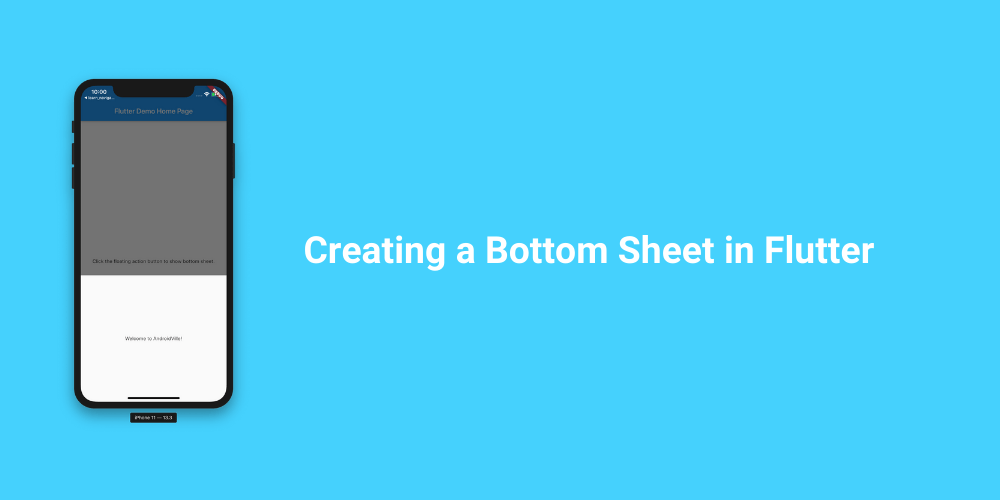In one of my previous articles, I outlined how to create a bottom sheet in React Native. In this short tutorial, we’ll see how to create a bottom sheet in Flutter.
This is by far the easiest framework I’ve encountered on creating a bottom sheet. It literally just involves calling a simple method. So this’ll be short and quick.
Getting Started
First step of this tutorial is to create a new flutter project. If you haven’t already installed flutter, check out this article on how to install flutter on your machine.
This tutorial will guide you with a step by step tutorial. Next, after you’ve installed flutter, create a new flutter project.
➜ ~ flutter create bottomsheet_tutorial
Creating the bottom sheet
First, get rid of the initial code that you’re provided by default. We’ll write our own.
We’ll create a floating action button, and on clicking it, we’ll display a bottom sheet. To create a floating action button in flutter, you’ll need a Scaffold. Scaffold in flutter allows us to use Material Design elements such as AppBar, floating action button, navigation drawer and so on.
import 'package:flutter/material.dart';
void main() => runApp(MyApp());
class MyApp extends StatelessWidget {
@override
Widget build(BuildContext context) {
return MaterialApp(
title: 'Flutter Demo',
theme: ThemeData(
primarySwatch: Colors.blue,
),
home: MyHomePage(title: 'BottomSheet demo'),
);
}
}
class MyHomePage extends StatefulWidget {
MyHomePage({Key key, this.title}) : super(key: key);
final String title;
@override
_MyHomePageState createState() => _MyHomePageState();
}
class _MyHomePageState extends State<MyHomePage> {
@override
Widget build(BuildContext context) {
return Scaffold(
appBar: AppBar(
title: Text(widget.title),
),
body: Center(
child: Column(
mainAxisAlignment: MainAxisAlignment.center,
children: <Widget>[
Text(
'Click the floating action button to show bottom sheet.',
),
],
),
),
floatingActionButton: FloatingActionButton(
child: Icon(Icons.add),
),
);
}
}
Next up, we’ll pass a function reference to onPressed of the floating action button. This is the function where we’ll create our bottom sheet in flutter.
import 'package:flutter/material.dart';
void main() => runApp(MyApp());
class MyApp extends StatelessWidget {
@override
Widget build(BuildContext context) {
return MaterialApp(
title: 'Flutter Demo',
theme: ThemeData(
primarySwatch: Colors.blue,
),
home: MyHomePage(title: 'BottomSheet demo'),
);
}
}
class MyHomePage extends StatefulWidget {
MyHomePage({Key key, this.title}) : super(key: key);
final String title;
@override
_MyHomePageState createState() => _MyHomePageState();
}
class _MyHomePageState extends State<MyHomePage> {
@override
Widget build(BuildContext context) {
return Scaffold(
appBar: AppBar(
title: Text(widget.title),
),
body: Center(
child: Column(
mainAxisAlignment: MainAxisAlignment.center,
children: <Widget>[
Text(
'Click the floating action button to show bottom sheet.',
),
],
),
),
floatingActionButton: FloatingActionButton(
onPressed:() => displayBottomSheet(context),
child: Icon(Icons.add),
),
);
}
}
Now call showModalBottomSheet, this is a method provided by flutter. It takes a context and a builder function. We’ll use an anonymous function as our builder function.
import 'package:flutter/material.dart';
void main() => runApp(MyApp());
class MyApp extends StatelessWidget {
@override
Widget build(BuildContext context) {
return MaterialApp(
title: 'Flutter Demo',
theme: ThemeData(
primarySwatch: Colors.blue,
),
home: MyHomePage(title: 'BottomSheet demo'),
);
}
}
class MyHomePage extends StatefulWidget {
MyHomePage({Key key, this.title}) : super(key: key);
final String title;
@override
_MyHomePageState createState() => _MyHomePageState();
}
class _MyHomePageState extends State<MyHomePage> {
void displayBottomSheet(BuildContext context) {
showModalBottomSheet(
context: context,
builder: (ctx) {
return Container(
height: MediaQuery.of(context).size.height * 0.4,
child: Center(
child: Text("Welcome to AndroidVille!"),
),
);
});
}
@override
Widget build(BuildContext context) {
return Scaffold(
appBar: AppBar(
title: Text(widget.title),
),
body: Center(
child: Column(
mainAxisAlignment: MainAxisAlignment.center,
children: <Widget>[
Text(
'Click the floating action button to show bottom sheet.',
),
],
),
),
floatingActionButton: FloatingActionButton(
onPressed:() => displayBottomSheet(context),
child: Icon(Icons.add),
),
);
}
}
Note: I’ve used MediaQuery to limit the size of bottom sheet to 40% of screen height.
Conclusion
And it’s done! This is all you need to do to create a bottom sheet in flutter. As I said, this is by far the easiest framework I’ve encountered to create a bottom sheet.
In the upcoming tutorial, I’ll show you how to create a bottom sheet using Native Android.
Welcome to AndroidVille 🙂
AndroidVille is a community of Mobile Developers where we share knowledge related to Android Development, Flutter Development, React Native Tutorials, Java, Kotlin and much more.
We have a SLACK workspace where we share updates related to new job opportunities, articles on Mobile Development/updates from the industry. We also have channels to help you with any questions, dev-help that you require. Just post a question and people would be ready to help you out 🙂
Click on this link to join the AndroidVille SLACK workspace. It’s absolutely free!
If you like any article, do give it a share on Facebook, Linkedin. You can follow me on LinkedIn, Twitter, Quora, and Medium where I answer questions related to Mobile Development, especially Android and Flutter.
If you want to stay updated with all the latest articles, subscribe to the weekly newsletter by entering your email address in the form on the top right section of this page.

